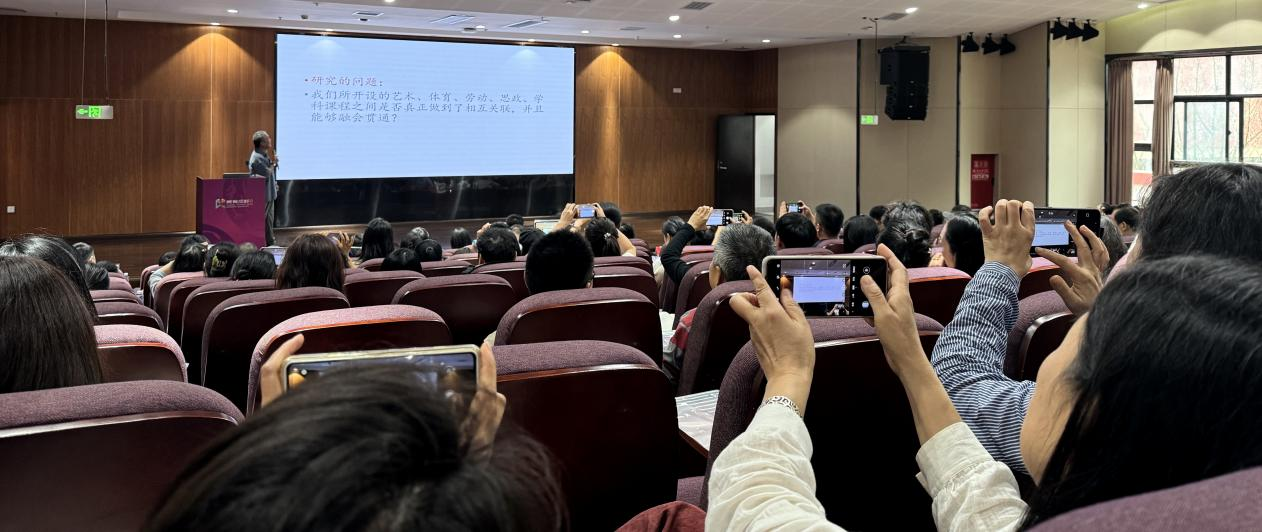New Chapter in Chengdu’s Aesthetic Education: TASA Supports Research on Aesthetic Education Immersion and Evaluation in Chengdu

Figure 1: Event poster
On the afternoon of September 30, 2025, the Promotion of Three-Year Plan for School Aesthetic Education Immersion Actions in Chengdu and Inauguration Ceremony for School Aesthetic Education Evaluation Reform Project was successfully held at Chengdu Art & Sports Middle School in Sichuan Province. Co-hosted by the Chengdu Municipal Education Bureau and the Tsinghua (Qingdao) Academy of Arts and Science Innovation Research (TASA), this event aimed to thoroughly implement the relevant documents issued by the Ministry of Education and People’s Government of Sichuan Province regarding aesthetic education immersion actions, comprehensively advance the execution of the Three-Year Work Plan for the Full Implementation of School Aesthetic Education Immersion Actions in Chengdu (from September 2025 to September 2027), and officially launch the municipal-level key project “School Aesthetic Education Evaluation Reform.” This marks a critical step in integrating academic support with regional practice for school aesthetic education in Chengdu, ushering in a new phase of systematic and scientific development.
Attendees included ZHANG Zhenghua, Member of the Party Group and Deputy Director of the Chengdu Municipal Education Bureau; XU Yong, Head of the Division of Sports, Health, and Art Education of the Chengdu Municipal Education Bureau; WANG Shanshan, Level III Investigator of the Division of Sports, Health, and Art Education of the Chengdu Municipal Education Bureau; WANG Hui, Deputy Director of the Shuangliu District Education Bureau; LI Ping, Music Researcher of Chengdu Education Research Institute; LI Mu, Tenured Professor of Tsinghua University; GAO Dengke, Assistant Researcher at the Institute of Literature, CASS and Director of the Academic Committee of the Aesthetic Education Experimental Center, TASA; YU Miao, Deputy Director of the Aesthetic Education Experimental Center, TASA; TANG Xibo, Secretary of the CPC Committee of Chengdu Art & Sports Middle School; XU Tianfu, Principal of Chengdu Art & Sports Middle School; as well as those-in-charge from education bureaus of various districts (cities) and counties and representatives of outstanding aesthetic education teachers. The event was hosted by Chengdu Art & Sports Middle School, bringing together aesthetic education practitioners from across the city to draw a new blueprint for aesthetic education development.
ZHANG Zhenghua emphasized that aesthetic education, as an important carrier of fostering virtue through education, is a key link in promoting high-quality education development. He clarified the core concept of integrating aesthetic education into the entire process of education and teaching, advocating for the building of a comprehensive aesthetic education pattern. By doing so, aesthetic education will extend beyond art classes and permeate into the educational scenarios of every discipline, truly achieving the goal of enhancing people’s comprehensive qualities, shaping sound personalities, and solidifying spiritual foundations through aesthetic education across all disciplines. WANG Shanshan provided an in-depth interpretation of the Three-Year Work Plan for School Aesthetic Education Immersion Actions in Chengdu (Draft for Comments). In particular, with the vivid case of dialogue with plants, she shared how aesthetic education can integrate nature, life, and labor education, demonstrating the profound connotations of aesthetic education immersion. She also highlighted that aesthetic education is not the exclusive domain of art disciplines but rather a shared educational responsibility of all disciplines, which needs to be integrated into the entire teaching process. Professor LI Mu delivered a keynote speech on Aesthetic Education in the Five-Pronged Education, explaining the contemporary value and practical challenges of aesthetic education evaluation from a theoretical perspective. He pointed out that aesthetic education evaluation is not merely a technical issue but also related to educational philosophy. He called on to integrate the five-pronged education and focus on the coordinated development of students’ aesthetic literacy, disciplinary abilities, and innovative potential, so as to truly realize the promotion of teaching and learning through evaluation. GAO Dengke noted in the special guidance on aesthetic education research that the project aims to address challenges such as insufficient scientificity and uneven regional development in current aesthetic education evaluation, while establishing an evaluation system that aligns with national standards and reflects Chengdu’s characteristics. In the exchanges, multiple teacher representatives, including CHEN Shuai, Head of the art teaching and research group at Chengdu No. 7 High School, and HE Ni, Principal and Party Secretary of the Sichuan Symphony Orchestra Affiliated Primary School, shared their thoughts and suggestions on aesthetic education immersion and evaluation reform based on their frontline practices.
 Figure 2: Teachers immersed in the event
Figure 2: Teachers immersed in the event
From September 2025 to September 2027, Chengdu will advance aesthetic education evaluation reform in three stages: completing research and the establishment of master teacher studios, conducting in-depth research on projects and sub-projects, and ultimately generating a series of landmark achievements, such as the Methodology of Aesthetic Education Teaching · Aesthetic Education Evaluation and the Aesthetic Education Evaluation Guidelines for Chengdu Primary and Secondary Schools. These efforts aim to create a high-quality development system in aesthetic education covering all educational stages and integrating both in-school and out-of-school resources by 2027. The Chengdu Municipal Education Bureau and TASA will collaborate closely to build a modern school aesthetic education system in Chengdu centered around the core path of the immersion actions, which is characterized by the integration of artistic general education, the fusion of interdisciplinary aesthetic education, evaluation-driven development, and technology-empowered innovation. They will strive to forge a new highland for aesthetic education development that leads western China and establish a Chengdu model of aesthetic education with national influence.
